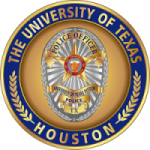Dry Conditions, Brush Fires Threaten Smithville Campus
September 01, 2020
The University of Texas Police at Houston's detachment unit at Smithville and Bastrop, along with local public safety agencies, responded to multiple brush fires in August. At least one grass fire resulted in the temporary evacuation of the The Virginia Harris Cockrell Cancer Research Center at The University of Texas MD Anderson Cancer Center.
According to the Texas A&M Forest Service, state officials are tracking an increased number of wildfire ignitions across Texas. Many of the recent wildfires are attributed to equipment use, welding, debris burning and roadside starts, such as sparks from tow chains, cigarettes or mechanical problems.
On Aug. 3, UT Police officers at the Smithville Campus responded to a 10-acre wildfire, called the Big Letter Fire, which came within a mile of the campus. By the next day, the Big Letter Fire was nearly completely contained with no structures under threat.
Another wildfire on Aug. 10 burned 50 acres of Bastrop State Park located about 10 miles northwest of the Science Park. Multiple local emergency response agencies aided in the containment of the large fire, along with two Bastrop County Emergency Service District helicopters that surveyed the fire and conducted water drop operations.
According to the Texas A&M Forest Service, a car caused a large brush fire about three miles northwest of the Science Park and forced a temporary evacuation of the campus during the afternoon of Aug. 14. Grasses in the area had been dried by consecutive 100-degree days.
UT Police and MD Anderson personnel located on the Smithville Campus routinely run annual evacuation training drills in the case of a wildfire emergency. UT Police Captain Wayne Smith, Jr., said that preparing for wildfire season is just like Houston preparing for hurricane season, "The key is staying prepared." And, with a robust emergency response plan, continual education and preparation, Captain Smith says, uniformed operations teams and MD Anderson personnel are well-prepared to initiate an evacuation response.
Wildfire evacuation training begins as a required part of the new employee on-boarding process. "Campus personnel are embedded in the emergency response plan," said Captain Smith. Building Unit Leaders, informally known as "Fire Wardens", are part of the Incident Command Team, which is the team used for the command and control of an emergency response, and are charged with organizing the evacuation of their assigned areas. Multiple Building Unit Leaders, typically comprised of administrative staff, are assigned to laboratory spaces throughout the building.
Annual evacuation training drills usually occur in the fall months following wildfire season, around October or November, and involve approximately 250 employees. This year's drills are currently being assessed due to COVID-19.
"Obviously, we won't be able to hold an in-person drill this year, so we're working on how we could hold a virtual drill for over 200 employees," said Captain Smith, "which, is no easy task."
Fortunately, this year's wildfires have caused no damage to structures at MD Anderson or in the city of Smithville. Mostly pasture and brush have taken the brunt of recent blazes.
